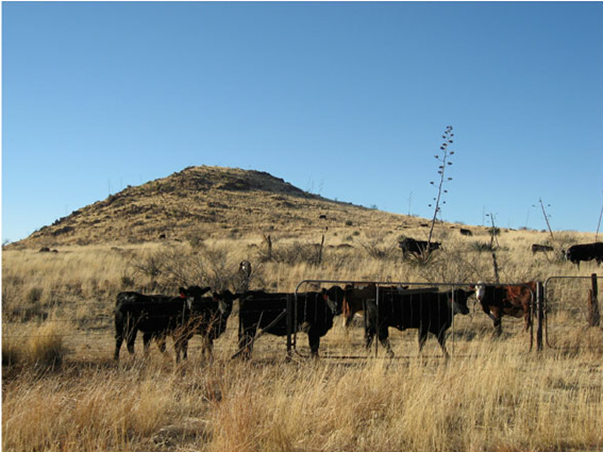Recent Changes in Cattle Grazing Settlements on Federal Lands
- The following is the opinion and analysis of the writer.
- Use of this article or any portions thereof requires written permission of the author.
Range Cattle

A new trend in grazing litigation[1] appears to have emerged which requires additional effort by the land management agency to limit cattle grazing on riparian areas home to endangered and threatened species under the Endangered Species Act (“ESA”). The three recent settlement agreements discussed below are groundbreaking for land management agencies: all three agreements require the agencies to be held directly accountable for the results of grazing. The agencies are required to monitor riparian areas, maintain and repair fencing, and remove trespass cattle. This development is important because it requires the agencies to take more of an immediate role in the conservation of riparian areas.
First, on August 18, 2021, the U.S. Forest Service (“USFS”) and the U.S. Fish and Wildlife Service (“US FWS”) reached an agreement with the Center for Biological Diversity (“CBD”) to prevent cattle from grazing more than 150 miles of streamside habitat from cattle grazing, covering 42 grazing allotments in the Arizona Apache-Sitgreaves National Forest and New Mexico Gila National Forest.[2] The agreement protects the habitats of endangered species along the Gila, San Francisco, Tularosa, and Blue rivers. There are several endangered and threatened species in the now-protected habitat, including southwestern willow flycatchers, yellow-billed cuckoos, Gila chub, loach minnow and spikedace fish, Chiricahua leopard frogs, and narrow-headed and northern Mexican garter snakes. The Forest Service is entrusted with monitoring these habitats.
Then, on October 13, 2021, USFS, US FWS, CBD, and the Maricopa Audubon Society reached an agreement to remove more than 140 miles of streamside habitat from cattle grazing, covering 22 grazing allotments in Arizona’s Prescott, Coconino, and Tonto national forests. It protects habitats along the Verde River, Fossil Creek, and other tributary streams of the same threatened and endangered species as the August 18 agreement. The Forest Service is entrusted with monitoring these habitats.[3]
Most recently, on September 12, 2022, a federal judge approved an agreement between the US FWS, Bureau of Land Management (“BLM”), CBD, and the Maricopa Audubon Society. This agreement removes all streamside habitats on the Gila Box Riparian National Conservation Area from cattle grazing, covering six grazing allotments. The now-protected habitats are home to the endangered or threatened western yellow-billed cuckoo, Gila chub, Gila topminnow, desert pupfish, loach minnow, and spikedace. The Bureau of Land Management is entrusted with monitoring these habitats.[4]
For decades, environmental organizations and ecologists have argued that cattle grazing is detrimental to the environmental health of the southwest.[5] These new agreements appear to be a step by the BLM and other land management agencies to address these concerns. The livestock industry, however, argues that research shows cattle are an important part of maintaining a healthy ecosystem.[6] As these parties continue to conflict on a path forward, land management agencies are left struggling to determine the best plan to conserve the land.
The new data that will be collected as a result of these new agreements will likely be helpful in determining land planning in years to come. The San Pedro Riparian National Conservation Area is a good example of an area of federal land which would greatly benefit from extensive research: because no data exists showing the benefits or detriments of cattle grazing, the BLM could not, without challenge by the affected ranchers, limit cattle grazing. As such, the BLM reached an agreement with environmentalists to renew four grazing leases, which should provide enough data to allow BLM to make an informed decision regarding the path forward.[7]
While the livestock industry opposes these agreements, there is a growing trend among land management agencies to limit cattle grazing in favor of habitat protection.
[1] Anna Miller, Grazing Agreements Reached in AZ, CA, Western Livestock Journal (Sep. 16, 2022), https://www.wlj.net/top_headlines/grazing-agreements-reached-in-az-ca/ar....
[2] Stipulated Settlement Agreement, Center for Biological Diversity v. U.S. Forest Service, No. 4:20-cv-00020-DCB (D. Ariz. 2021); Geoffrey Plant, Feds Settle Grazing Suit, Silver City Daily Press (Aug. 31, 2021), https://www.scdailypress.com/2021/08/31/feds-settle-grazing-suit/; Agreement Reached to Protected Endangered Species From Livestock on Arizona, New Mexico Waterways, Center for Biological Diversity (Aug. 18, 2021), https://biologicaldiversity.org/w/news/press-releases/agreement-reached-....
[3] Stipulated Settlement Agreement, Center for Biological Diversity v. U.S. Forest Service, No. 3:20-cv-8243-PCT-DGC (D. Ariz. 2021); Bob Christie & Jonathan Cooper, Feds Agree to Keep Cattle Out of Northern Arizona Rivers, US News (Oct. 14, 2021), https://www.usnews.com/news/best-states/arizona/articles/2021-10-14/feds... Agreement Reached to Protect Endangered Species From Livestock on Arizona’s Verde River, Center for Biological Diversity (Oct. 13, 2021), https://biologicaldiversity.org/w/news/press-releases/agreement-reached-....
[4] Stipulated Settlement Agreement, Center for Biological Diversity vs. U.S. Bureau of Land Management, No. CV 21-411-TUC-RM (DTF) (D. Ariz. 2022); Anna Miller, Grazing Agreements Reached in AZ, CA, Western Livestock Journal (Sep. 16, 2022), https://www.wlj.net/top_headlines/grazing-agreements-reached-in-az-ca/ar... Agreement Reached to Protect Endangered Species From Livestock in National Conservation Area in Arizona, Center for Biological Diversity (Sep. 12, 2022), https://biologicaldiversity.org/w/news/press-releases/agreement-reached-....
[5] Georgina Gustin, The Bureau of Land Management Lets 1.5 Million Cattle Graze on Federal Land for Almost Nothing, but the Cost to the Climate Could be High, Inside Climate News (July 25, 2022), https://insideclimatenews.org/news/25072022/the-bureau-of-land-managemen....
[6] Joe Duhownik, Damage to Riparian Areas Where Cattle Graze Renews Debate over Use of Public Lands in Arizona, AZ Central, https://www.azcentral.com/story/news/local/arizona-environment/2022/08/2....
[7] Shar Porier, BLM Agrees to Address Grazing Issues on the SPRNCA, Herald Review (Aug. 8, 2022, updated Aug. 13, 2022), https://www.myheraldreview.com/news/cochise_county/blm-agrees-to-address....

